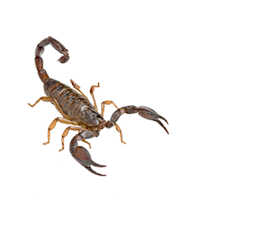

They have great ecological importance because they are the main predators of insects and other small animals. Just like spiders, ticks and mites, scorpions belong to the class Arachnida. Its length can vary between 1 and 20 cm and they differ from insects by having four pairs of legs, and not having wings or antennae.
They are easily recognized due to their protruding curved tail, where the stinger is located, and a pair of pedipalps ending in claws. The scorpion's sting injects venom to capture prey or to defend themselves.
Resistant to temperatures between 0 and 55°C, scorpions inhabit virtually every continent except very cold regions, such as Antarctica.
They are reclusive and have nocturnal habits. In urban areas it is possible to find scorpions where there is accumulation of debris and construction materials, in vacant lots, gardens, etc. Indoors, they can be hidden in dark places like tight spaces, basements, closets and warehouses.
All scorpions are venomous, but only 25 species are deadly to humans. Their venom is also used to pre-digest the viscera and organs of their prey.
Treatment for this venom must be done in the hospital, and it's a good measure to capture and take the scorpion with you to facilitate diagnosis and treatment.






















